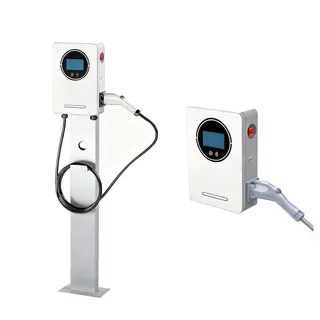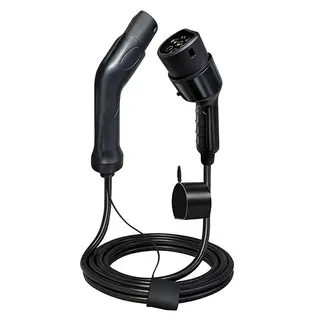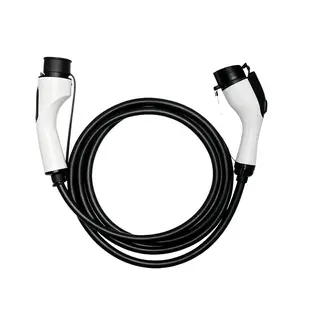With the increasing popularity of electric vehicles today, charging stations, as an important energy replenishment facility, have also become a focus of public attention. There are various types of chargers, among which integrated chargers and split chargers are the most common. Each has its own characteristics and is suitable for different scenarios and needs. This article will provide a detailed introduction to the structure, advantages, disadvantages, and applicable scenarios of these two types of EV chargers to help everyone better choose the charger that suits them.
EV chargers can be divided into integrated and split types according to their structure. An integrated EV charger is a complete charging device that integrates the main body of the EV charger, the charging gun, the charging cable, and all other components together. This design makes the integrated EV charger look more compact and relatively easy to install.
A split EV charger separates the control unit, billing unit, charging interface, human-machine interaction interface, and other parts, except for the charging gun, which are all weak-current circuits. The power unit's charging module and the strong-current distribution circuits are concentrated together. This split design allows each part of the charger to be flexibly arranged according to the actual site conditions.
The internal structure of an integrated EV charger is relatively compact, integrating the power supply, controller, charging head, and other components into a single cabinet. This design makes the integrated charger relatively large in size but very easy to install. Users only need to fix the integrated EV charger in a parking lot or other fixed location, connect the power supply, and it can be used directly. Since the internal power supply and control circuits are already integrated, no additional wiring is required, making the installation process relatively simple and fast.

Convenience: The greatest advantage of integrated EV chargers is that they are very easy and quick to use. Users do not need extra operations when charging; as long as the electric vehicle is connected to the EV charger and the charging gun is plugged in, charging can begin. This simple and intuitive operation makes integrated EV chargers especially suitable for new users who are not familiar with charging operations.
Fast Charging Speed: Integrated EV chargers usually charge faster than split EV chargers, allowing charging to be completed in a short time. This makes integrated EV chargers particularly suitable for commercial places or highways where quick charging is needed. For example, at highway service areas, vehicles need to complete charging quickly and continue driving, and integrated EV chargers can meet this demand well.
Small Space Occupation: The volume of an integrated EV charger is relatively small, roughly the size of a large refrigerator, and it does not occupy space when installed next to a parking spot. This makes integrated EV chargers especially suitable for residential parking spaces, street-side shops, and other areas with limited space.
High Cost: Integrated EV chargers require the purchase of the entire device, which is relatively expensive. During production, more engineering and processing are required, including integrating various components together, which increases the overall cost.
Difficult Maintenance: Components in an integrated EV charger are highly coupled. Once a component fails, it may affect the normal operation of other components. Repairs are complicated, requiring professional technicians, and replacement and maintenance are difficult.
Cooling Issues: Most integrated EV chargers rely on air cooling, like using a small fan to cool the device. While this method is low-cost, during high-power charging, heat can accumulate quickly, and the small fan may not be sufficient. Especially in hot summer conditions, some lower-quality fast-charging integrated EV chargers may slow down or even stop when working continuously.
Integrated EV chargers are particularly suitable for commercial places or highways where rapid charging is required. In commercial locations such as shopping centers or hotels, customers need to complete charging quickly and continue their journey; the fast-charging capability of integrated EV chargers meets this requirement well. On highways, where vehicles need to charge quickly and continue driving, integrated EV chargers provide timely energy replenishment. In addition, integrated EV chargers are suitable for logistics parks where vehicles charge in batches and street-side shops providing temporary charging to customers.
Split EV chargers consist of the main EV charger unit and the charging gun. The main unit is usually installed on a wall or stand, while the charging gun is connected via cable. This split design makes the EV charger relatively small, lightweight, and suitable for indoor or outdoor environments. Split EV chargers are relatively flexible to install, using wall-mounting or stands, and are easy to install and remove. Independent component design allows flexible layout according to actual site conditions, meeting different user needs.

Flexible Installation: Split EV chargers can be installed according to site conditions, either on walls or using stands. This flexibility makes split EV chargers especially suitable for small parking spaces, residential complexes, and similar scenarios. For example, in the underground garage of a residential complex with limited space, split EV chargers can be flexibly mounted on walls without occupying extra space.
Modular Design: Split EV chargers adopt a modular design, with each module independently designed, making it convenient to replace individual modules during maintenance. In case of failure, problems can be quickly located and handled without replacing the whole unit, significantly reducing maintenance costs. This modular design not only extends the service life but also stabilizes charging performance.
Dynamic Power Allocation: Through modular charging modules, split EV chargers can dynamically allocate power. Within the same electrical capacity, vehicles requiring high-power charging can receive faster charging speed. For example, in large bus depots, dozens of vehicles charging simultaneously can receive power allocation as needed from the main unit, improving charging efficiency.
Effective Cooling: High-power split EV chargers often use liquid cooling. Coolant circulates through the charging gun cable, quickly dissipating heat, effectively solving heat problems during high-power charging and ensuring stable operation.
Relatively Complex Operation: Split EV chargers require manual connection of the charging cable. Users must connect the charging gun to the main unit and then plug the gun into the EV charging port to begin charging. This operation may be cumbersome for users unfamiliar with charging.
Relatively Lower Cost: Split EV chargers allow separate purchase of the charging gun and main unit. With a simpler structure, production costs are lower, and selling prices are relatively low. While cheaper to buy, split EV chargers require users to spend more time and effort learning and operating them.
Split EV chargers are more suitable for small parking spaces, residential complexes, and similar scenarios. In residential underground garages with limited parking space, split EV chargers can be flexibly mounted on walls without taking up extra space and provide slow charging services to residents. They are also suitable for large logistics centers, highway fast-charging stations, and bus terminals requiring high-power charging. For example, at highway fast-charging stations, vehicles need to charge quickly and continue driving. Split EV chargers' high-power capability and dynamic power allocation provide fast charging and relieve range anxiety.
When choosing an EV charger, comprehensive consideration of site conditions and usage requirements is necessary to select the most suitable solution. If space is limited and fast charging is needed, an integrated EV charger may be a better choice. Integrated EV chargers are small, easy to install, and fast-charging, meeting these needs well.
If space is larger and flexible layout with high-power charging is needed, a split EV charger may be more suitable. Split EV chargers offer flexible installation, modular design, and dynamic power allocation, satisfying various user needs.
Additionally, the cooling method should be considered. If the EV charger must operate for long periods in high temperatures, liquid-cooled split EV chargers may be more reliable. Cost and maintenance difficulty should also be taken into account. If budget is limited and maintenance cost reduction is desired, split EV chargers' modular design and lower repair cost may be an important factor.
Integrated and split EV chargers each have their advantages and disadvantages, suitable for different scenarios and needs. Integrated EV chargers are convenient, fast-charging, and space-saving but are more expensive, harder to maintain, and may face cooling issues. Split EV chargers are flexible in installation, modular, offer dynamic power allocation, and have effective cooling, but are relatively complex to operate and have lower purchase costs. When choosing a EV charger, comprehensive consideration of site conditions and usage requirements is necessary to select the best option. Whether integrated or split, both types of EV chargers provide vital support for the development of electric vehicles, making our travel more convenient and environmentally friendly.



